A few years ago, Eco Brooklyn’s director became certified as a LEED AP. Till this day we have yet to certify a job with LEED. This is because we easily attain LEED Platinum standards and feel it falls short on many levels. So we put our money and energy on other things we feel are more important in contributing to making a green building. Having said that, here are our pros, cons, and analysis of LEED. First, let’s discuss a beginner’s introduction to LEED before we get into the more technical analysis…
Background and Overview
According to the USGBC, The green building market in the United States is projected to more than double from $43 billion in 2008 to $120 billion by 2013. In 2005, green building comprised just 2 percent of non-residential new construction and is expected to grow to nearly 25 percent of new construction in 2013. Most of this impressive growth is due to the LEED (Leadership in Environmental Energy and Design) green building program.
LEED is an internationally recognized green building certification, providing third-party verification system for buildings and communities that are designed and built using practices intended to improve site selection, water efficiency, energy consumption, resource use, and indoor environmental quality. LEED was created by the USGBC (United States Green Building Council) in August 1998, five years after their formation in 1993.
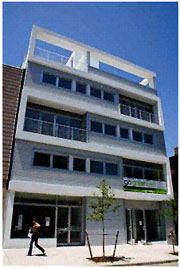
LEED was created with the intention to provide a framework for building owners and operators a framework for creating and implementing practical and measurable green building design, construction, and maintenance solutions. The primary users of LEED are the United States and Canada, totaling over 5,500 projects.
Buildings and communities can achieve four possible levels of LEED certification that are ranked using a 100-point scale:
-Certified (40-49 points)
-Silver (50-59 points)
-Gold (60-79 points)
-Platinum (80+ points)
Furthermore, the 100-point system is broken down into six categories:
-Sustainable Sites
-Water Efficiency
-Energy and Atmosphere
-Materials and Resources
-Indoor Environmental Quality
-Innovation Design
-Locations and Linkages (only for LEED for Homes)
-Awareness and Education (only for LEED for Homes)
Each of these categories encompasses several “credits,” at least one of which is required prerequisite for any level of LEED certification. Examples of the required credits are construction activity pollution prevention, water use reduction by 30% baseline, and fundamental commissioning of building energy systems.
LEED buildings and communities, along with LEED professional credentialing are both certified through the GBCI (Green Building Certification Institute), a body created by the USGBC in 2008. In order to certify a LEED project an individual has to attain accreditation from the GBCI through a series of tests.
Pervasiveness of LEED
In recent years, green building in the United States has been consumed by LEED certification. The federal government has begun adopting LEED as a standard. The federal government has taken a keen liking to LEED; the following federal government entities have required LEED certification for all of their new buildings:
-Air Force
-Army
-Navy
-Department of Energy
-Department of the Interior
-Environmental Protection Agency
-General Services Agency
-State Department
State governments have begun to catch on to the LEED craze as well. Here is a list of states that require LEED certification for all state funded public buildings:
-California
-Connecticut
-Maine
-Maryland
-Massachusetts
-New Mexico
-Nevada
-Rhode Island
Along with state government LEED requirements counties and cities across the nation are also mandating LEED certification for all new funded public buildings. Even if a mandate is not created by a governing body, many states, cities, and counties encourage LEED certification for all funded projects.
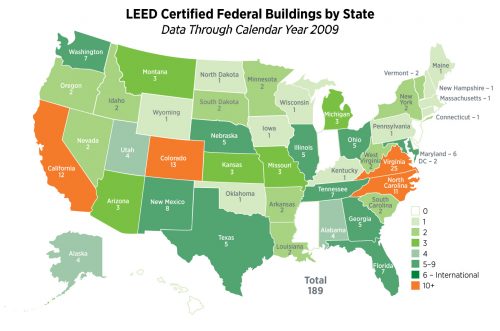
So it is evident that many building professionals such as architects, engineers, contractors, and consultants all strive towards LEED certification when they want to “build green”. So is this a good thing? What are the disadvantages and advantages of the process? Is LEED effective in reducing environmental impact of our built surroundings?
Disadvantages of LEED
Currently, LEED has over 1,965,835,916 ft.2 of certified commercial space throughout the world, totaling to exactly 33,150 projects. The growth of LEED-certified buildings also seems to be recession proof: despite a precipitous decline in new construction because of the bursting of the real-estate bubble, the total square footage of LEED-certified buildings grew by 14%.
Despite LEEDs prevalence as a certification system for green building, it still has many disadvantages. One of the main drawbacks of LEED is that it is quite expensive; LEED certification adds four to eleven percent to a project’s construction costs. Additional costs for LEED certifications has been estimated anywhere from $2,500 upwards to $25,000. Incremental costs for LEED are added on because of specific design, documenting, compliance certification, and verifying compliance through the commissioning process.
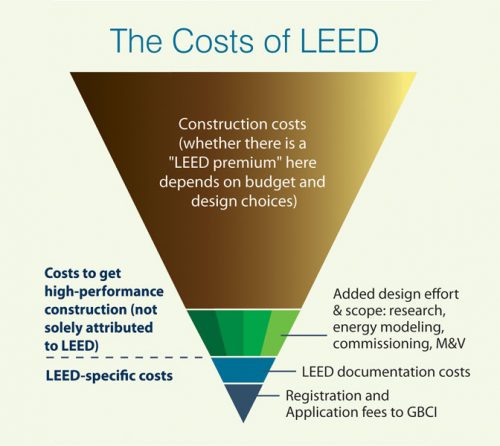
Zealous green builders scorn LEED by stating that the process is driven by scoring points and not designing sustainable buildings for a particular site and use; a phenomenon termed ‘LEED brain’. Instead of creating a green building that reflects the neighborhood and region in which its built, LEED creates a cookie-cutter green building that can be placed anywhere in the country.
A large part of the green building process is the organic design and creation. LEED stifles the creative process by providing strict guidelines on what to build.
There is also much admonition about the actual LEED credits. First of all, there is a lot of discrepancy about the weight of certain credits. The same amount of points are given to installing a bike rack outside the building as you would receive if you redeveloped a brownfield site. You can even receive a credit point for involving a LEED AP (Accredited Professional) Installing a 10 person bike rack is quite cheap, whereas revitalizing a brownfield site over a conventional site is extremely expensive because of bioremediation.
This leads to perverse economic incentives. Contractors are more likely to take advantage of the cheaper option. Remediating brownfields creates many positive externalities that reduce health problems in the neighboring community and support plant and animal life. But positive externalities are often not internalized within the costs of the building. Therefore many developers and contractors would choose the easier and cheaper option over the option that reaps the most positive externalities.
Another disadvantage (or grievance) of LEED is that it promotes green building that, in some cases is not actually ‘green’. In October of 2010, Henry Gifford filed a class action lawsuit against USGBC in the Southern District of New York filed a lawsuit against the USGBC. The suit alleges abuses of the Sherman and Lanham Acts for “deceiving users” of the LEED system about whether LEED buildings use less energy than conventionally-built buildings.
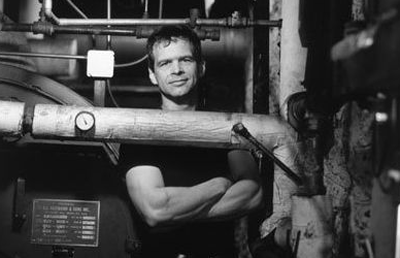
Gifford stated that, “I’m afraid that in a few years somebody really evil will publicize the fact that green buildings don’t save energy and argue that the only solution [to resource constraints] is more guns to shoot at the people who have oil underneath their sand”. Essentially, he is hoping to make the green building movement more legitimate so it is not embarrassed in the future and dire actions need to be taken.
A few months later the Court dismissed the federal false advertising claims “with prejudice”. It is true that some LEED-certified buildings do not perform up to their optimal energy performance though. In 2011, the USGBC has moved to implement verification of performance and help to any buildings that do not reach LEED-efficient measures.

The last disadvantage of LEED is that the credits do not encompass many green building aspects. LEED does not address land use and ecology of a building at all. A newly constructed LEED certified building could destroy a robust native ecosystem, and be built on an invaluable section of a watershed; and none of these actions would be reflected in the certification process.
Any building are destroys habitats should not be considered green. In addition, if a ecosystem were to be destroyed for a construction of a LEED building, there is no incentive to develop a new ecosystem according to the credit system. As a NY green landscaper and a zealous green builder, one of Eco-Brooklyn’s main goals is to creative beautiful native ecosystems. To not do so in the construction of a green building is a travesty.
The LEED certification system also does not address the user awareness and education of inhabitants or visitors of its buildings, besides for a certification plaque placed on a recognizable place on or within the building. Without user awareness and education, inhabitants are not cognizant of the green building aspects within the building. By making inhabitants aware, they are more likely to conserve energy use, and live a more environmentally aware lifestyle.
Advantages of LEED
One of the main benefits of LEED is that the USGBC has created a multitude of different rating systems that cater to specific types of buildings. Here is a list of the various types of rating systems:
-New Construction
-Existing Buildings: Operations and Maintenance
-Commercial Interiors
-Core and Shell
-Schools
-Retail
-Healthcare
-Homes
-Neighborhood Development
The simplest yet most profound advantage of LEED is that it provides guidelines on how to create a green building with any type of building that you would like to construct. The options are plentiful: you can outfit your office to be LEED certified with commercial interiors, gut out a collegiate academic building and retrofit it with existing building, and build green schools, stores, hospitals, homes and neighborhoods with the LEED rating system.
LEED is a powerful tool because it allows various types of buildings to be built ‘green’, according to specific guidelines. Consequently, this permits normal contractors and architects to build a green building according to LEED standards.
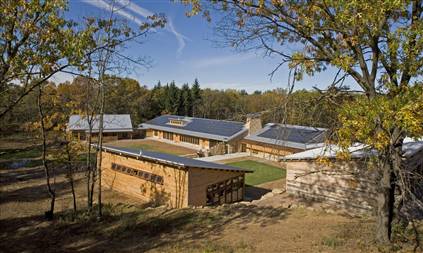
Another strongpoint of LEED is its pervasiveness throughout the world. With projects in over 135 countries in the world, LEED has become the most widely recognized benchmark for green buildings around the world. LEED addresses the needs of projects in regions across the world and allows for the development of solutions unique to an area while maintaining consistency. Simply put, LEED certification, like the classic environmental mantra, strives to think globally but act locally.
LEED also offers compelling proof to you, your clients, your peers, and the public at large that you have achieved your environmental goals and your building is performing as designed. By gaining LEED certification you automatically open yourself up to different grants and funding opportunities.
Certain certifications are known to the general public, which could potentially (not definitely) transfer to higher property value of the building. It you take a quick stroll through a gentrified neighborhood in Brooklyn, you will see dozens of renovated apartment buildings advertising their LEED certification.
Another advantage of LEED is that it turns larger more expensive projects that are inevitably going to be built to become more environmentally sound. For example, the reconstruction of the new World Trade Center area is unavoidably going to be built. I do not think the technology exists for buildings of that magnitude to be truly green, and that is where LEED comes in. Essentially, instead of building a energy inefficent behemoth, LEED allows the stakeholders to design and build an environmentally sound structure.

Analysis and the Future of LEED
Simply put, LEED is a monster that definitely cannot be contained. In terms of green building certification systems, LEED is here to stay. LEED allows non-green builders to get their foot in the door of green building, allowing LEED to become the new norm for all newly constructed and renovated buildings.
Essentially, LEED is a watered down version of real green building. In coming years, the USGBC needs to change LEED standards drastically to promote net zero energy buildings that use mostly salvaged materials.
As a zealous New York green contractor, we believe that LEED needs to be completely revamped. It is becoming too late in the global climate change era to create and renovate buildings that are not completely environmentally sound. The USGBC needs to include green building aspects such as land use and ecology, maintenance and operation, socio-cultural aspects, function, and user awareness and education.
Each credit within the LEED rating system should be weighted in regard to its environmental impact, alleviation of climate change, difficulty, and resource conservation. Each credit should not simply be given 1 point, but rather different numbers to provide an incentive for contractors and architects to tackle the more difficult, yet rewarding credits.
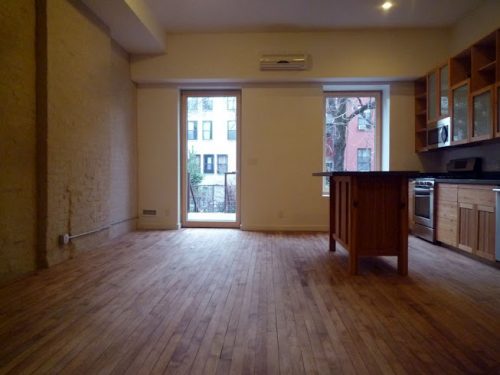
LEED also needs to intensify the qualifications of their credits and pre-requisites all across the board. The pre-requisites such as water use reduction, minimum energy performance, and fundamental commissioning of building energy systems need to be intensified. The credits such also need to be accentuated. For example, for Water Efficiency Credit 3: Water Use reduction you can obtain 2 points for a 30% reduction, 3 points for a 35% reduction, and 4 points for a 40% reduction according to a standard baseline. These percentages should be increased in the future to further reduce water use in LEED buildings.
Eco-Brooklyn focuses on renovating brownstones into net-zero energy homes using 100 percent salvaged materials, among various other environmental projects such as soil remediation, green landscaping, and green roof installations. We build tangentially to passiv haus guidelines, but do not strive to achieve certification. We try our hardest to eliminate all environmental impact by eliminating waste in our construction process.
Because we believe in a form of radical sustainability, LEED seems to be a lame version of green building to us. Building a structure that used 30% less energy, 20% less water, and 30% recycled materials is not a green building, it is rather a more efficiently built structure.
We would eventually like to see LEED standards at a level where the minimum rating is a net zero energy building, and the rest are buildings that actually produce energy and feed it back into the grid. But these standards need to advance rapidly to advance humans’ built environment, and provide a solution to our moral obligation to eliminate global climate change.
